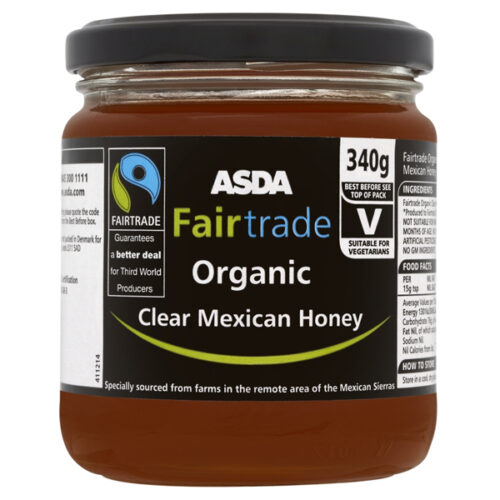While updating our posts on honey recently, we took a look at which brands of Mexican honey sell overseas and how these brands are labeled. Let’s take a closer look at two of them.
First up is Alasia Honey, labeled as “Pure Mexican Yucatan Tropical Forest Honey”. The smaller print says that “This Mexican honey is from the tropical forests of the Yucatan peninsula, the ancient heart of the Maya people, where beekeeping has been a spiritual art for thousands of years.” Great description, and sounds pretty accurate in all respects. Native Mexican honeybees were, and are, important to the Maya people, and the natural vegetation of most of the Yucatan Peninsula is, indeed, tropical evergreen forest.
Next up is Asda Mexican Fairtrade Organic Clear Mexican Honey:
Anytime the “Fairtrade” name is used, most people assume that it is likely to be more respectful to the producers, and probably also assume that any further description will be culturally sensitive and geographically accurate. This is only partly true for the Asda honey. Below the Fairtrade symbol, it says “Guarantees a better deal for Third World Producers.” The term “Third World” slipped out of fashion (for good reason) a long time ago, so hardly counts as contemporary development terminology.
The small print along the bottom of the label says, “Specially sourced from farms in the remote areas of the Mexican Sierras”. Hmm… really?? There are several areas of high relief in Mexico that are named “Sierra” (“Mountain Range”), the two major ones being the Western Sierra Madre and the Eastern Sierra Madre, both well to the north of Mexico’s main honey-producing states. Most organic honey in Mexico comes from the Yucatán Peninsula, where there are no Sierras. Hence, the claim that this honey originates in “remote areas of the Mexican Sierras” is, at best, geographically ambiguous, and at worst, geographically inaccurate.
We don’t know which honey tastes better, but we do know which has the more honest and culturally-sensitive labeling!
- The geography of honey production in Mexico
- The diffusion of the Africanized honey bee in North America: a bio-geographical case study
Related posts:
2 Responses to “Honey, what’s on that label?”
Sorry, the comment form is closed at this time.


Like an arrow to the heart.
ASDA was once known as Associated Dairies. When I was a 12 year old lad I delivered their milk in one pint glass bottles door to door between 4.30am and 7am. The people needed milk for their tea and I had to get to school after my second breakfast.
ASDA was bought out by WalMart as a way to get into the UK and therefore the EU.
To think that the once proud and pure ASDA is mislabeling … I need a cuppa tea, milk no honey!!!
Sorry about the arrow to the heart. I remember glass milk bottles (and school milk) all too well. If you come across other interesting labels related to Mexico, please let me know!